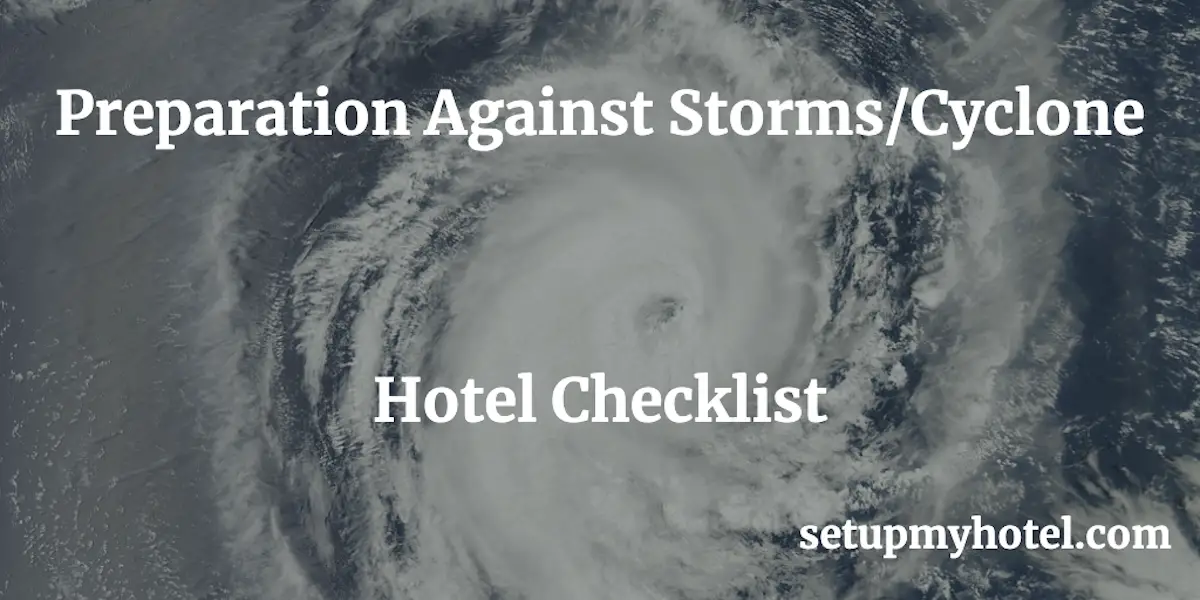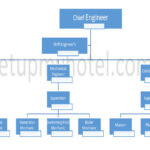Checklist For The Preparation Against Storms/Cyclone/Flood
Hotels located in areas prone to storms, cyclones, and floods need to be well-prepared to ensure the safety of their guests and staff. A comprehensive plan should be in place that covers all aspects of emergency preparedness, from evacuation procedures to communication protocols.
Firstly, it is important to assess the risks and vulnerabilities of the hotel’s location and take appropriate steps to mitigate these risks. This may include reinforcing the building’s structure, installing shutters or storm windows, and securing loose items that could become dangerous projectiles in high winds.
In addition, hotels should have a clear evacuation plan in place that is regularly reviewed and updated. This plan should include designated safe areas, emergency exits, and a communication strategy to ensure that guests and staff are aware of the situation and what actions they need to take.
Hotels should also have emergency supplies readily available, such as first aid kits, food, water, and temporary shelter. Staff should be trained to respond quickly and effectively in an emergency situation and have the necessary skills to provide basic first aid.
Finally, communication with guests is key in any emergency situation. Hotels should have a clear communication plan that includes regular updates on the situation, instructions on what to do, and contact information for emergency services.
The following example gives an idea of how a checklist can be prepared:
1. Activation of management
- Identify a person who will take on each of the following eight major responsibilities.
- Building (hotel/resort).
- Emergency shelter coordination and supplies.
- CommunicationsCommunications� means the sending and receiving of messages..
- Employee coordination.
- GuestDefinition of Guest in Hospitality Industry: A guest is the most important person in any business. A... roster maintenance.
- Evacuation coordination.
- Travel assistance and transportation coordination.
- SecuritySecurity is the prevention of theft; fire; and other emergency situations in the workplace. coordination.
2. Preparing the resort
(a) Verify the status of:
- Emergency communications equipment, including walkie-talkies and mobile telephones.
- FireFire are chemical decomposition of a fuel element through combustion or burning. For fire to occur a... protection systems.
- Lightning protection systems.
- Water-level monitoring systems.
- Overflow detection devices.
- Automatic shutoffs.
- (Rechargeable) batteries, and emergency power-generation systems.
- Fuel supplies (full if possible).
- Hazardous materials storage.
(b) Define shutdown conditions
- Determine who can order the shutdown of major resort elements (including evacuation).
- Determine how a partial shutdown would affect other facility operations.
- Verify the length of time required for shutdown and restart.
- Specify the conditions that could necessitate a shutdown and provide this information to the decision-maker in conjunction with information on what parts of the facility would be affected and the time needed to shut down and restart.
- Determine who would carry out shutdown procedures.
(c) Preserve vital records
- Secure vital records not needed during the emergency. Store computer tapes and disks in insulated and waterproof containers.
- Initiate backup of computer systems.
- Ensure your web services are redundantly available on servers outside the storm area.
- Arrange for evacuation of records to backup facilities.
(d) Secure outside facilities
- Move equipment to protected areas.
- Move the furniture inside buildings.
- Remove banners, flags, and vulnerable potted plants and artwork.
- Relocate livestock and move pets to indoor facilities.
- Secure materials to shutters or protect windows.
(e) Prepare shelter facilities (if appropriate), Clear and organize interior rooms for:
- Guest and employee occupation.
- Food, fuel, and luggage storage.
- Food distribution.
- Sanitary needs.
- Communications.
- Provide for emergency heat, lighting, and cooking.
3. Emergency shelter coordination and supplies
- Determine for whom the facility will be used as an emergency shelter site (i.e. guests, employees, essential operational employees).
- Base action on the items below on this decision:
- If the facility is NOT intended to be a shelter, identify official shelters and evacuation sites and prepare directions to them.
- If the facility WILL provide shelter, verify the accessibility and adequate provision of fuel, food water, blankets, pillows, and first aid supplies to the sheltered areas of the facility.
- Verify telephone and backup communication lines to civil authorities and emergency assistance.
4. Communications
- Move communications equipment to the shelter space and test it to verify it works. This should include radios and, where possible, telephones and televisions.
- Distribute portable short-range two-way radios to managers, coordinators, critical acility locations, and security staff.
- Establish backup communications procedures which might include human messengers (runners).
- Activate automatic call divert to a specialized call center in the event of disrupted phone lines (important for communication with relatives).
- Coordinate with civil authorities regarding facility intentions and status.
- Establish a ‘Message Board’ for posting announcements on the status of the storm, warnings, evacuation notices, travel advisories, and telephone numbers for assistance and emergencies.
- Ensure that your web services are redundantly available on servers outside the storm area (mirror servers).
- Arrange for web maintenance during and after the storm to disseminate important information to relatives and stakeholders (transmit important server access information to headquarters and other (company) resorts outside the storm area).
- Copy and distribute checklists and advisory notices for tourists and guests.
5. Employee coordination
- Identify and notify critical employees needed at the facility for the preparation or maintenance and operation during the storm.
- Provide checklists and advisory notices to employees and their families.
- Determine the need for employee sheltering and inform shelter coordinators.
6. Guest and employee roster
- Provide a log for guest and employee sign-in and sign-out.
- Prepare and maintain a roster of current employees and guests.
- Establish a file in which to maintain data provided by guests about their home addresses, emergency family contacts, and travel plans.
- Upon evacuation, update the roster with information on departures and intended destinations.
7. Evacuation coordination
- Determine evacuation conditions for the various categories of tourists, guests, non-critical employees, and critical employees.
- Verify who decides to evacuate the facility.
- Determine and post the evacuation routes and destination points.
- Establish notification procedures to announce an evacuation.
- Upon the decision to evacuate, contact civil authorities on facility intentions and evacuation progress.
8. Travel assistance and transport coordination
- Identify commercial and emergency travel coordinators for the airline, train, and bus lines.
- Announce the availability of emergency travel assistance.
- Contact tour directors and determine transport requirements and the availability of any additional seats, if they have their transport. Post the availability of such opportunities.
9. Security Coordination
- Determine security requirements during emergency preparations, the onset of the storm, and immediately after the storm.
- Establish when security resources should be brought to the facility and when they should be deployed.
- Identify a coordination center for security resources and supply it with appropriate emergency communications equipment.
- Coordinate with communications in the event of security problems and the need for civil assistance.
By taking these steps, hotels can ensure that they are well-prepared for storms, cyclones, and floods, and can provide a safe and secure environment for their guests and staff. Natural disasters such as tropical storms, cyclones, and floods leave little or no time to prepare for the onset. The preparation of checklists is therefore of major importance and should not be neglected by resorts in areas that are likely to be affected.











